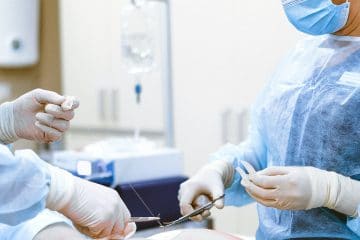Post-operative Exercises – Overview
Post-operative exercises are recommended for pain management, strength training and recovery following surgery.
Exercise is generally beneficial for healthy living and wellness and postoperative exercises are even more important.
Advantages of Postoperative exercises
The advantages of post-op exercise are as follows:
1. Restore normal movement to the joint
2. Build up strength in the joint and surrounding muscles
3. Ease pain and swelling
4. Guide an individual back to normal activities
5. Help with circulation, particularly right after surgery, so the patient does not have problems with blood clots
More: Benefits of Exercise
Postoperative Exercises For Abdominal Surgery
The following exercises are designed to reduce the risk of complications such as abdominal weakness or low back pain following your surgery. These exercises should not be painful to do.
It is important to do them daily as outlined below.
1. Pelvic tilting
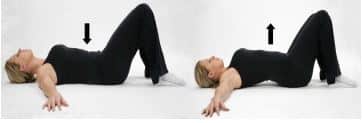
This exercise helps to prevent/ease back pain by encouraging spinal mobility.
Lie on your back with your knees bent and both feet on the floor/bed.
Keeping your knees together, gently tighten your tummy muscles so that the hollow in your back is pressed against the floor/bed.
2. Knee rolling
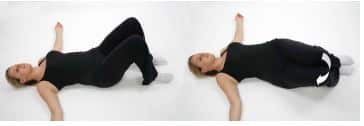
This is an important exercise to keep your trunk mobile.
Lie on your back with your knees bent and both feet on the floor/bed.
Keeping your knees together, slowly lower both knees to one side and then the other.
3. Abdominal hollowing in 4 point kneeling
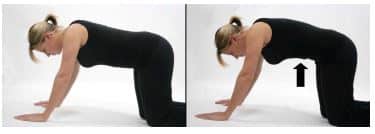
This exercise will help to begin to strengthen your tummy muscles.
Kneel on all fours keeping your back as straight as possible.
Gently tighten the muscles in the lower part of your tummy without arching your back.
Hold the position for 5 seconds and relax.
Repeat this exercise 10 times, 3 times a day.
Advance Postoperative exercises for abdominal surgery
After 6 weeks from the date of your surgery you may add the following exercises:
1. Abdominal curl-ups

Lie on your back with your knees bent and both feet on the floor/bed.
Keeping your knees together, place a hand on each thigh.
Lift your head and shoulders off the floor by sliding your hands along your thighs towards your knees.
Slowly lower your head and shoulders back to the floor
2. Abdominal oblique curl-ups

Lie on your back with your knees bent and both feet on the floor/bed.
Keeping your knees together, place your right hand on your left thigh.
Lift your head and right shoulder off the floor by sliding your right hand along your left thigh towards your left knee.
Slowly lower your head and shoulders back to the floor.
Repeat this exercise on your other side by sliding your left hand towards your right knee.
3. Bridging

Lie on your back with your knees bent and both feet on the floor/bed.
Keeping your knees together and arms by your side, live your bottom off the floor as high as you can.
Hold for a few seconds and then lower yourself onto the floor/bed.
It is important to continue all these exercises until you feel you are back to normal, that is, back to work if appropriate, having regained your fitness and range of movement as before, and enjoying sports and activities. This can sometimes take at least 12 weeks.
Postoperative Exercises for Hip and Knee Replacement
Orthopedic surgeries such as total hip replacement, knee replacement, meniscus repair surgery often require extended rehabilitation periods with exercises aimed at improving the strength and stability of the operated parts.
Your orthopedic surgeon and physical therapist may recommend that you exercise for 20 to 30 minutes, 2 or 3 times a day during your early recovery. They may suggest some of the exercises shown below.
Early Postoperative Exercises
These included exercises that should commence as soon as you are able. You can begin them in the recovery room shortly after surgery. You may feel uncomfortable at first, but these exercises will help speed your recovery and diminish your postoperative pain.
Ankle Pumps

Slowly push your foot up and down. Repeat this exercise several times, as often as every 5 or 10 minutes.
Begin this exercise immediately after surgery and continue it until you are fully recovered.
Ankle Rotations

Move your ankle inward toward your other foot and then outward away from your other foot.
Repeat 5 times in each direction.
Do 3 or 4 sessions a day.
Bed-Supported Knee Bends
Slide your foot toward your buttocks, bending your knee and keeping your heel on the bed. Do not let your knee roll inward.
Hold your knee in a maximally bent position for 5 to 10 seconds and then straighten.
Repeat 10 times.
Do 3 or 4 sessions a day.
Abduction Exercise
Slide your leg out to the side as far as you can and then back.
Repeat 10 times
Do 3 or 4 sessions a day
Quadriceps Set
Tighten your thigh muscle. Try to straighten your knee. Hold for 5 to 10 seconds.
Repeat this exercise 10 times for 10 minutes, rest one minute and repeat.
Continue until your thigh feels fatigued.
Standing Exercises
Soon after your surgery, you will be out of bed and able to stand. You will require help at first but, as you regain your strength, you will be able to stand independently.
While doing these standing exercises, make sure you are holding on to a firm surface such as a bar attached to your bed or a wall.
Standing Knee Raises
Lift your operated leg toward your chest. Do not lift your knee higher than your waist. Hold for 2 or 3 counts and put your leg down.
Repeat 10 times.
Do 3 or 4 sessions a day.
Walking
Proper walking is the best way to help your hip recover. At first, you will walk with a walker or crutches. Your surgeon or therapist will tell you how much weight to put on your leg.
Advanced Exercises
Elastic Tube Exercises
Resistive Hip Flexion
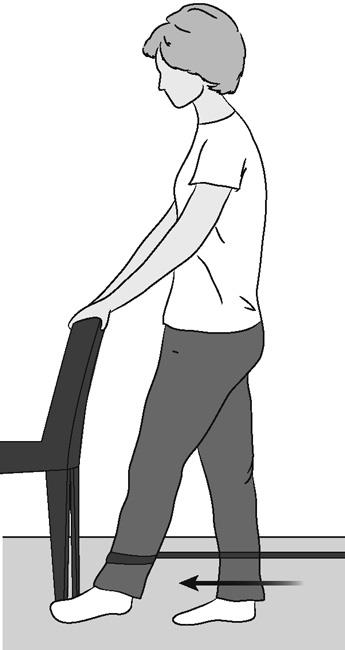
Stand with your feet slightly apart. Bring your operated leg forward keeping the knee straight. Allow your leg to return to its previous position.
Resistive Hip Abduction
Stand sideways from the door to which the tubing is attached and extend your operated leg out to the side. Allow your leg to return to its previous position.
Resistive Hip Extensions
Face the door to which the tubing is attached and pull your leg straight back. Allow your leg to return to its previous position.
Swimming

Swimming is one of the best aquatic exercises for people who are recovering from a hip replacement.
If you’re a good swimmer, try swimming a couple of laps. After feeling comfortable doing this, gradually increase your laps. If your swimming skills aren’t that strong, use a kickboard that floats to do freestyle kicks.
Exercycling
Exercycling is an excellent activity to help you regain muscle strength and hip mobility.
At first, adjust the seat height so that the bottom of your foot just touches the pedal with your knee almost straight. Pedal backward at first. Ride forward only after a comfortable cycling motion is possible backward.
As you become stronger (at about 4 to 6 weeks) slowly increase the tension on the exercycle. Exercycle for 10 to 15 minutes twice a day, gradually building up to 20 to 30 minutes, 3 or 4 times a week.
Read More: Inguinal Hernia Surgery


